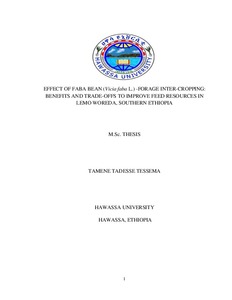Effect of faba bean (Vicia faba l.)- forage inter-cropping: Benefits and trade-offs to improve feed resources in Lemo Woreda, southern Ethiopia
Abstract
Faba bean (Vicia faba L.), also called ‘broad bean, horse bean’ is an annual crop, which mainly grows in the highlands of Ethiopia for human consumption. The objective of this study was to evaluate the effects of intercropping faba bean varieties with oat fodder on forage biomass, straw, grain yields, and straw quality. For the household survey 108 households (HHs) were selected from two kebeles (53 from Upper Gana and 55 from Jawe kebeles). The average HH family size, land and livestock holdings were 5.53 heads, 1.39 ha and 6.73 heads, respectively. Cultivation of forage crops was not widely practiced in the Woreda, but farmers have an experience of not weeding faba bean plots to get more weed biomass. The field trial involved a 3×5 factorial experiment with three replications, whereby three faba bean growing management practices were tested with five faba bean varieties. Samples were taken from each treatment plots. The highest (P<0.01) tiller count, number of pods per plant (PPP), seeds per pod (SPP) and grain yield was under improved management, whereas the lowest (P<0.01) was under intercropping management practice. The highest (P=0.0053) faba bean straw dry matter yield (DMY) (t ha-1) was for Tumsa under improved (9.82) and the lowest (P=0.0053) straw dry matter yield (DMY) (t ha-1) was for CS-20DK (1.70) under intercropping management practice. The total feed dry matter (DM), crude protein (CP) and metabolizable energy yields were greater (P<0.05) under intercropping than the remaining management practices. Walki (12.36%) under intercropping had the highest CP content and the lowest CP contents were observed for Tumsa (6.73%) and Dosha (6.65%) under traditional management. The mean CP content was highest (P<0.05) under intercropping and lowest (P<0.05) in traditional management practice. The NDF content was lower under intercropping than the remaining management practices. The ADF content (%) varied from 51.72(Walki) to 64.3 (Gebelchu), 45.38 (CS-20DK) to 68.27 (Gebelchu) and from 46.47 (Walki) to 62.39 (Tumsa) under traditional, improved and intercropping management. The highest (P=0.0306) acid detergent lignin content was observed for Dosha in improved management and the lowest (P=0.0306) was for Walki and CS-20DK under intercropping management. In vitro true organic matter digestibility value (%) ranged from 43.32 (Tumsa) to 51.11 (CS-20DK) in traditional management, from 45.72 (Tumsa) to 51.02 (Walki) under improved management and from 46.47 (Tumsa) to 55.71 (CS-20DK) under intercropping management practice. In vitro true dry matter digestibility (IVTDMD) value was higher (P<0.05) under intercropping than other management practices. The metabolizable energy value (MJ/kg DM) was highest (P=0.0398) for CS-20DK (7.97) under intercropping and lowest for Tumsa (6.19) in traditional management practice. Also intercropping management gave highest net benefit (49319 ETB ha-1) as compared to the remaining management practice. It can be concluded that intercropping based on different faba bean varieties with oats could be feasible to provide reasonable nutritive value of forages in the crop-livestock systems of Ethiopia.

